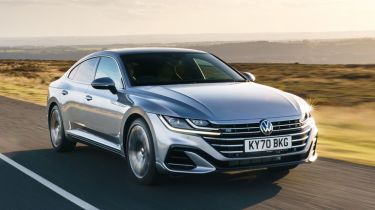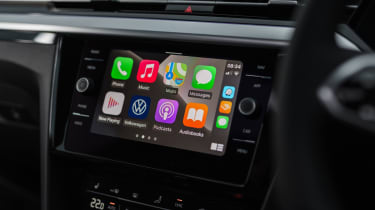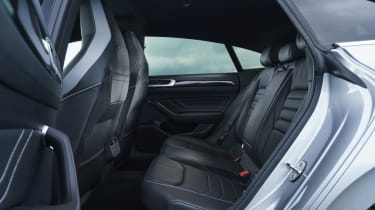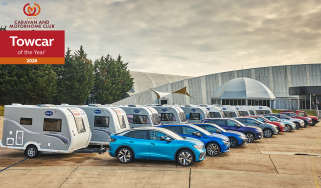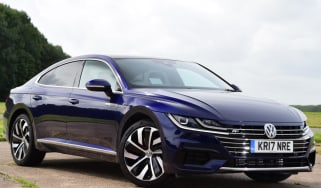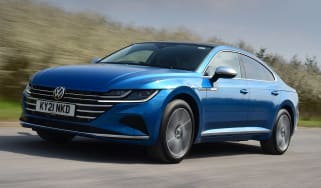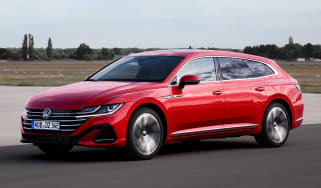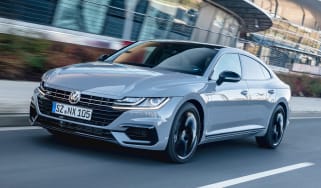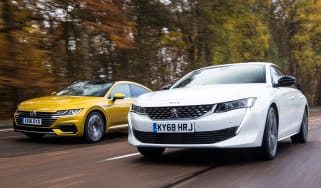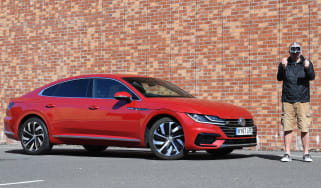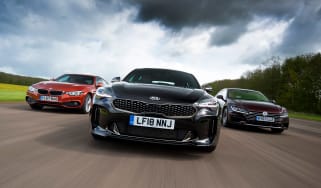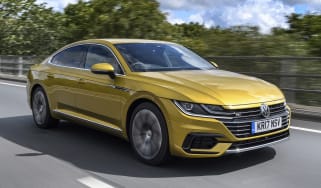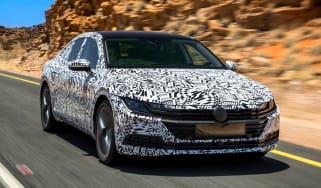Volkswagen Arteon (2017-2024) review
The VW Arteon is a dramatically styled hatch with a luxury feel that takes on premium executive rivals

Just so you know, this is an older review of the 2017-2024 Volkswagen Arteon. If you are interested in a review about a used Volkswagen Arteon, or news about the latest Volkswagen models, please follow the links provided.
There’s not much to criticise about the Volkswagen Arteon if you’re a style-conscious executive with big miles to cover. It has all the style, technology and luxury required to take on premium-badged rivals like the Audi A5 Sportback or BMW 4 Series Gran Coupe, coupled with low running costs and reasonable company car tax bills.
OK, so it doesn’t provide quite as many thrills behind the wheel as a BMW, and the VW badge doesn’t have the cachet of some rivals, but the high-end cabin is beautifully built and covered in premium materials. Like all its style-led coupe-inspired rivals, the Arteon suffers from limited headroom in the back for taller passengers, but the refined ride and rakish styling still make it a winning choice.
About the Volkswagen Arteon
The flagship model of the VW passenger car range is the Volkswagen Arteon, and it was the latest in a line of large executive models built by the German firm. Following on from the Passat-based CC and the even more opulent Phaeton as a plush saloon car for the masses, the Arteon was first introduced in 2017. However, VW’s executive car range has expanded with the arrival of both the new Passat and the fully-electric ID.7 in early 2024. Given the brand’s push towards electrification and concentration on core, volume-selling models, the future for the Arteon seems uncertain.
Used - available now

2022 Volkswagen
Arteon
34,426 milesAutomaticDiesel2.0L
Cash £23,435
2020 Volkswagen
Arteon
67,235 milesAutomaticDiesel2.0L
Cash £16,350
2019 Volkswagen
Arteon
45,821 milesAutomaticDiesel2.0L
Cash £18,257
2018 Volkswagen
Arteon
56,440 milesAutomaticPetrol1.5L
Cash £14,499Like the CC that it replaced, the Arteon relies on the Mk8 Passat family car for its running gear, but it gets sporty, eye-catching bodywork that gives it a look in line with the latest breed of coupe hatchbacks, such as the Audi A5 Sportback and BMW 4 Series Gran Coupe. These are the Arteon's main rivals, although it could also be considered an opponent to other compact executive saloons such as the Jaguar XE, Alfa Romeo Giulia and Mercedes C-Class.
Underneath the stylish bodywork, the Arteon is available with either front-wheel drive or 4MOTION four-wheel drive. Six-speed manual models are available, but most Arteons come with VW's fast-shifting seven-speed DSG twin-clutch auto gearbox. This emphasises the car's pretensions as an upmarket cruiser.
A minor facelift in 2020 saw the introduction of some exterior styling tweaks and extra on-board tech, while an Arteon Shooting Brake estate was introduced at the same time.
The core TSI turbo petrol engines comprise a 148bhp 1.5-litre unit with a six-speed manual transmission and a 187bhp 2.0-litre powerplant mated to seven-speed automatic DSG gearbox. Company car drivers will be best off with the plug-in 1.4-litre TSI eHybrid. This carries the lowest Benefit-in-Kind rate of the Arteon line-up, and up to 37 miles of pure-electric range. Sitting at the top of the range is the R performance model with 4Motion four-wheel drive and a 316bhp version of the 2.0-litre TSI petrol engine. VW's ubiquitous 2.0 TDI diesel comes in 148bhp and 197bhp forms, with all variants offered as seven-speed automatics. If you want 4MOTION four-wheel drive, you’ll need the more powerful unit.
Reflecting the Arteon's upmarket pretensions, there are just two mainstream trim levels, Elegance and R-Line. Elegance trim is plush, with fully adaptive LED headlights, LED interior lighting, heated leather seats with electric adjustment for the driver's seat, an 8-inch sat-nav infotainment system, adaptive cruise control for DSG-equipped cars and VW's 10.25-inch Digital Cockpit Pro set-up.
How much does the Volkswagen Arteon cost?
On top of that, the R-Line gets a sportier look with 19-inch wheels and additional exterior and interior trim. The entry-level 1.5-litre petrol engine is only available in R Line trim and starts from almost £42,000, with the Elegance trim starting from just over £43,000 with the 2.0-litre petrol engine. The R performance model is approaching £60,000 and, as with the rest of the range, you pay around £1,000 more if you want the Shooting Brake body style.
Engines, performance and drive
On the road, the Arteon is a little softer than its aggressive styling might suggest, but it really excels as a long-distance motorway cruiser. The Passat was already supremely efficient in this regard, and the extra cabin luxury and slippery body styling of the Arteon mean it’s even more comfortable, quiet and refined on long hauls.
If you want driving thrills, there’s no doubt a BMW 4 Series Gran Coupe provides a more responsive experience. The Arteon’s steering offers little road feel, and switching the DCC adaptive dampers to Sport mode reins in the body roll but at the noticeable expense of ride comfort.
We ended up leaving the DCC system in Comfort – which can occasionally feel floaty – or Normal, most of the time. This last setting works very well, with a decent balance between ride comfort and body control, but it’s an acknowledgement that being a good all-rounder is the Arteon’s strongest suit. When we pitted the Arteon face-to-face with the Audi A5 Sportback in a twin test, we found it narrowly offered a better driving experience, even though the noise levels were higher.
Engines, 0-60 acceleration and top speed
When it comes to powering the Arteon, there’s a fairly wide range of engines to choose from. Traditionalists will be pleased to hear that diesel power is still available, and this comes in the form of a 2.0-litre TDI. Depending on your chosen spec, this engine produces either 148bhp and 350Nm of torque or 197bhp and 400Nm.
Both diesels have a seven-speed DSG transmission fitted as standard, but you’ll need the more powerful unit if you want a 4MOTION four-wheel drive. The 148bhp diesel will propel the Arteon from 0-62mph in 9.3 seconds, while the 197bhp unit reduces this time to 7.9 seconds.
If you prefer petrol power, you have a choice of two engines. The smaller of the two is a 148bhp 1.5-litre TSI unit, which is only available with a six-speed manual gearbox. This manages the 0-62mph sprint in 9.0 seconds. Upgrading to the larger 187bhp 2.0-litre TSI changes the transmission to a seven-speed DSG automatic, and this combination results in a 7.9-second sprint.
A 1.4-litre plug-in hybrid caters for company car drivers. The Arteon eHybrid’s powertrain produces 215bhp and 250Nm of torque, so it packs a reasonable amount of punch with a 0-62mph time of 7.8 seconds. Along with improved fuel efficiency and lower emissions, the 13.0kWh battery also claims up to 37 miles of fully-electric range.
For those who crave outright performance, the 316bhp R performance model is rapid, with its 420Nm of torque helping it to 62mph from a standstill in 4.9 seconds and onto a top speed of 155mph.
MPG, CO2 and running costs
With prices starting from around £41,000, the Arteon is priced to compete with rivals from Audi and BMW, especially considering that all Arteons are equipped with standard kit that’s usually optional on rivals. With all Arteons now costing over the £40,000 barrier, they will be subject to the £390 tax supplement for years two to six.
The 1.4-litre TSI eHybrid is the most efficient model in the Arteon range. It’s able to travel up to 37 miles on electric power alone and has a combined fuel economy figure of 243.3mpg – with the obvious caveat being that you need to ensure the battery is plugged in regularly to get anywhere near that figure. With CO2 levels of 26g/km, company car users are only liable for a Benefit-in-Kind (BiK) tax rate of 12 per cent.
After the Plug-in hybrid, the 2.0-litre diesel is the most economical alternative. The 148bhp variant returns up to 55.9mpg, with CO2 emissions of 132g/km. The 197bhp diesel incurs a slight penalty for its extra performance with 51.6mpg and 143g/km. If you opt for the 4MOTION four-wheel drive system, this engine will suffer a further performance penalty, resulting in 47.1mpg and 157g/km.
Buyers after the hot R model probably won't be prioritising overall efficiency, which is just as well, seeing as it's only capable of 32.2mpg on the combined cycle and emits 199g/km of CO2.
Insurance groups
The insurance groupings for the Volkswagen Arteon range from group 22E for the 148bhp petrol, up to group 35E for the hot R variant. The letter E means the Arteon exceeds the minimum security requirement for its class, which has qualified it for a lower insurance group.
Depreciation
Like any big executive car, the Volkswagen Arteon’s depreciation figures will likely hit the wallet quite hard. Our data suggests that, on average, the Arteon should retain between 39.60 and 46.47 per cent of its original list price after three years and 36,000 miles of ownership. This applies to both the saloon and Shooting Brake variants.
To get an accurate valuation for a specific model, check out our free car valuation tool...
Interior, design and technology
Some of the Volkswagen line-up looks a little homogenous from the styling perspective, but that isn’t an accusation you can throw at the Arteon. It has visual panache and dynamism to compete with the best the premium marques can throw at it.
The fun starts at the front, with a broad, deep grille that flows into the headlamps, while deep contours run up the bonnet, above powerful front wings with crisp wheelarches. The side profile is rakish, with frameless windows and the ‘uplighter’ effect of sculpted lower door panels, while the swoopy rear end has equally muscular arches and a very contemporary-looking rebate detail running the entire width of the car beneath the tail-lights.
A refresh in 2020 brought new LED headlights, a revised radiator grille with integrated daytime running lights, a reshaped front bumper, and redesigned LED rear lights. Interior changes included a new multi-function steering wheel, touch-sensitive air-con controls and a new upper dashboard panel. An optional 700-watt Harman/Kardon stereo system is also available.
The interior is very stylish for a VW product. The most eye-catching styling element is the ventilation slot that runs the full width of the dash, which is shaped to mimic the Arteon’s front grille. Other interior features include VW’s 10.25-inch Digital Cockpit Pro, which replaces traditional analogue instruments. You can set the system up to show a variety of information, including the sat-nav mapping, which is otherwise displayed on the big eight-inch display screen at the top of the centre console.
While the interior look and feel is lavish but not flashy, there’s certainly an impressive amount of technology on offer. One of the highlights is a Driver Assist package that brings a ‘predictive’ function to the cruise control and driving lights – the former reduces speed for impending corners or speed limit changes, while the lights set themselves up for corners before you arrive at them.
Sat-nav, stereo and infotainment
The standard sat-nav is the Discover system, which comes with a DAB radio, Bluetooth, an SD card reader and an eight-speaker audio set-up. You can upgrade to Discover Navgation Pro at an additional cost, which brings a bigger 9.2-inch touchscreen, increased functionality including voice activation, DVD and a 64 GB hard drive.
Practicality, comfort and boot space
There’s no doubt that the Arteon provides a great deal of comfort for its occupants. It rides smoothly even on the largest diameter (20-inch) wheels, at least until you hit major imperfections on the road surface which can upset the serenity with a jolt. There’s also an additional comfort setting in the driving modes, but we think it adds too much ‘wallow’ and not enough extra smoothness. The engine noise is very well-damped, and the car quietly slips through the air.
There are loads of seat adjustments to ensure you’ll find a comfortable position. Once ensconced, the standard leather upholstery, three-zone climate control, great infotainment and lavish feel of the fit and finish should ensure the journey is relaxing.
Dimensions and size
The Arteon is a large car at 4,862mm long and 1,871mm wide, but it’s only 1,450mm from the tarmac to the roof. This makes it slightly larger than the Audi A5 Sportback, which comes in at 4,757mm x 1,843mm x 1,386mm.
Leg room, head room & passenger space
The Arteon has a relatively long wheelbase, which means there’s plenty of legroom in the back. However, that sloping rear three-quarter profile impacts headroom, and taller passengers will feel hard done by. The R-Line gets a dark ‘sporty’ headlining too, which can emphasise the lack of space in the rear by adding a slightly claustrophobic feel.
Boot space
There’s a decent-sized 563 litre boot lurking beneath the Arteon’s hatchback tail. The tailgate opens wide for good access, too, and if you want to maximise the luggage capacity, you can fold down the back seats to reveal a relatively cavernous 1,557-litre load area.
Reliability and safety
It looks thoroughly contemporary from the outside, but there’s plenty of shared engineering under the skin of the Arteon, all of which shouldn’t provide too many headaches on the reliability front. The Arteon hasn’t appeared in our 2023 Driver Power satisfaction survey, but Volkswagen ranked 27th out of 32 brands in our 2023 best manufacturer rankings — which is far from impressive.
Aside from the shared MBQ platform, all of the Arteon’s engines are established in the Volkswagen Group line-up, and the same applies to technology such as the active Info dash and Discover Nav systems. Some of the more advanced electronics systems are a bit more novel, but many of them are related to safety systems seen elsewhere in the VW range, and we’d hope that the most rigorous test and development regimes have been applied.
On the safety front, the Arteon’s 2017 five-star rating has expired because the latest Euro NCAP testing criteria have gotten a lot tougher. That doesn’t mean the Arteon isn’t safe, because it comes with an array of standard-fit safety kit, such as Lane Departure Warning and Brake Assist, but there are newer alternatives like the Genesis G80 that have passed more stringent testing with flying colours that you might wish to consider if safety is your primary concern.
Warranty
The VW Arteon comes with Volkswagen’s standard three-year/60,000-mile warranty. This used to be standard fare, but BMW and Mercedes both offer three years of cover with unlimited mileage.
Servicing
Volkswagen offers fixed or flexible servicing packages for the Arteon, depending on mileage covered and type of driving undertaken. Oil changes service intervals are annual or after 9,300 miles if you go for the fixed option, while this is increased to every two years (18,600 miles) under the flexible option.

